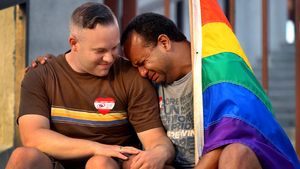1985 marked a pivotal turning point in the global AIDS crisis. What had been dismissed by many as a distant or marginalized epidemic suddenly became a central issue in public consciousness, driven by a confluence of activism, celebrity, and political reckoning.
Before 1985, the AIDS crisis was marked largely by government indifference, widespread stigma, and virtually no federal funding. It had been four years since stories of a “rare cancer” in gay men began being reported in the media in 1981. Compounding all of this was a devastating lack of public attention about the seriousness of HIV, fueled in part by the absence of high-profile figures willing or able to speak out.
On July 25, 1985, Hollywood icon Rock Hudson announced from a Paris hospital that he had AIDS. As he was the first major U.S. celebrity to publicly disclose an AIDS diagnosis, Hudson’s revelation shattered the illusion that the disease was confined to marginalized communities. Though Hudson never came out officially, his announcement seemed to confirm years of rumors that he was gay.
His death on October 2, 1985, at age 59, further galvanized public attention. Hudson’s illness and passing brought a recognizable face to the disease, prompting a surge in AIDS-related donations and awareness campaigns. For example, Elizabeth Taylor’s Commitment to Life benefit, initially planned for a small venue, had to be relocated to accommodate the overwhelming response following Hudson’s announcement. The fundraiser was the first major one for AIDS Project Los Angeles.
Despite the escalating crisis, President Ronald Reagan had remained notably silent on the issue. It wasn’t until September 1985, following Hudson’s diagnosis, that Reagan publicly addressed AIDS, referring to it as a “top priority” but simultaneously citing budget constraints as a reason why the federal government dragged its feet on funding AIDS-related programs.
By the end of the year, there were more than 12,000 reported AIDS-related deaths in the U.S. at the time out of about 15,000 total cases. Reagan’s delayed response drew criticism from activists and public health officials who had long urged federal action.
In the wake of governmental inaction, grassroots movements gained momentum. In 1987, the AIDS Coalition to Unleash Power, or ACT UP, was founded and emerged as a formidable force, organizing protests and demanding accelerated drug approvals, increased research funding, and comprehensive healthcare access. Its activism played a crucial role in shifting public perception and policy regarding AIDS.
Over the ensuing decades, significant strides were made in combating HIV and AIDS. Programs like the U.S. President’s Emergency Plan for AIDS Relief, or PEPFAR, initiated in 2003, contributed to substantial reductions in HIV-related deaths globally; it’s estimated to have saved as many as 26 million lives. However, recent developments have raised concerns about the sustainability of these gains.
In early 2025, the Trump administration implemented sweeping budget cuts affecting global health initiatives. PEPFAR experienced significant funding reductions, leading to decreased HIV testing and treatment services in countries like South Africa. Experts warn that these cuts could result in 60,000 to 74,000 excess HIV-related deaths over the next five years in sub-Saharan Africa alone.
Domestically, the Trump administration wants to cut discretionary funding to the Department of Health and Human Services by 26 percent in fiscal year 2026, affecting programs related to HIV prevention and research. These policy shifts have sparked protests and legal challenges from public health advocates and labor unions.
The events of the 1980s underscore the importance of visibility, advocacy, and political will in addressing public health crises. Rock Hudson’s courage in disclosing his illness, coupled with the relentless efforts of ACT UP and other activist groups, compelled a nation to confront the burgeoning epidemic. Today, as funding cuts threaten to reverse decades of progress, the lessons from that pivotal decade remain ever relevant.
As we remember the strides made since 1985, it’s imperative to recognize that the fight against HIV and AIDS is far from over. Sustained commitment, both domestically and internationally, is essential to ensure that the gains achieved are not lost and that the vision of an AIDS-free generation becomes a reality so that a year like 1985 doesn’t happen again.
This article originally published on our sister site advocate.com and is part of The Advocate's July/Aug 2025 issue, which hits newsstands July 1.
From Your Site Articles
Related Articles Around the Web













































































